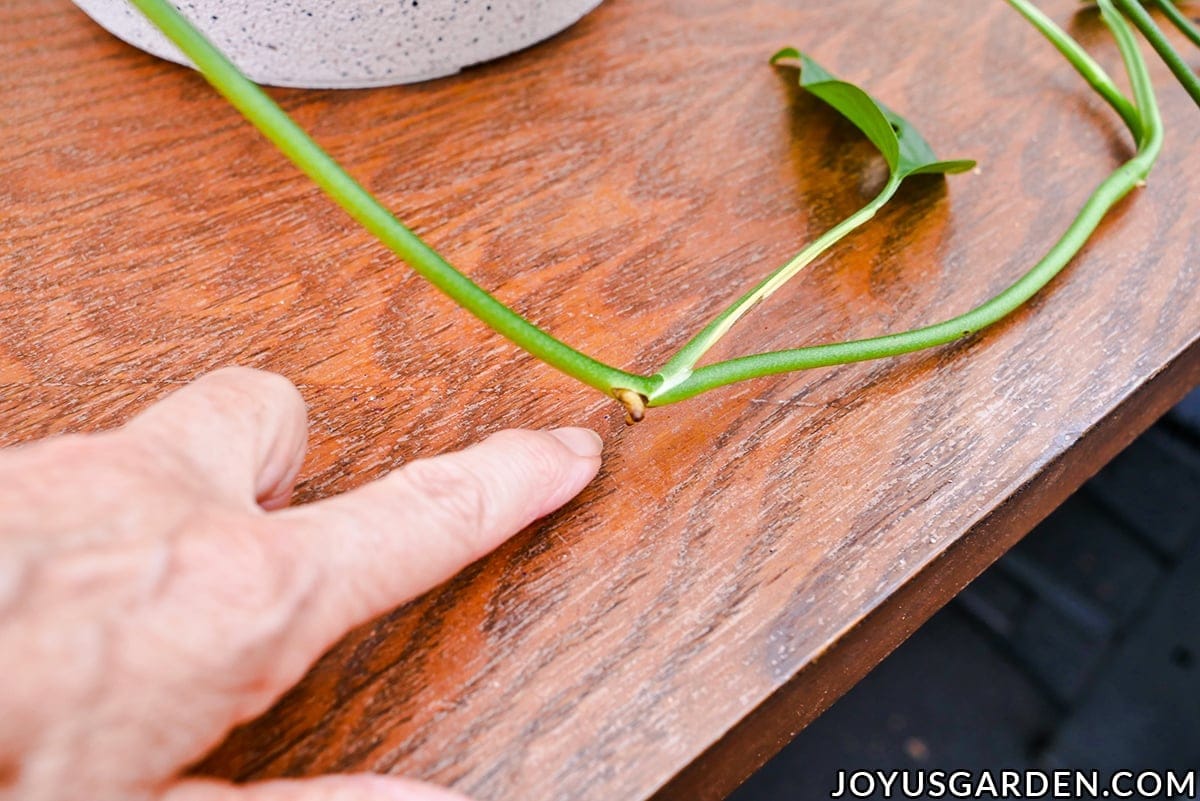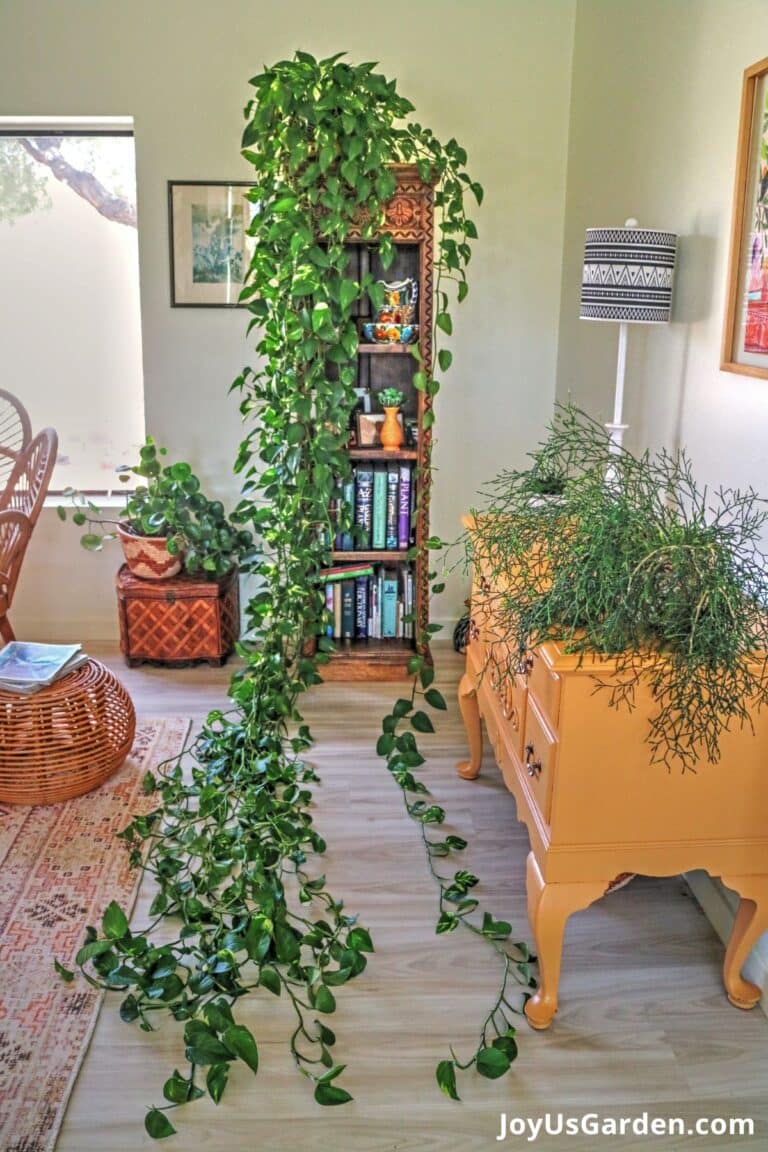Monstera Adansonii Care: Swiss Cheese Vine Growing Tips
The Swiss Cheese Vine is a popular trailing houseplant with unique cut-out foliage. Monstera adansonii care is easy, and I share growing tips to keep yours healthy and looking great.
This gorgeous, unique vine is beloved for its eye-catching, perforated leaves and wild training nature. Caring for your Monstera adansonii doesn’t have to be complicated. You can keep your lacy vine healthy, growing, and looking good with a few simple tips.
Botanic name: Monstera adansonii Common names: Swiss Cheese Vine, Five Holes Plant, Adanson’s Monstera
Monstera Adansonii Traits

I gave my Swiss Cheese Vine a big prune a few months ago. It’s filling in & looks much better now. You can see what it looked like before (plus me pruning it) by scrolling to the pruning video at the bottom.
What’s fun about this plant is that it can be left to trail, trained to climb, or both, like mine. When growing in its natural environment, a Monstera adansonii climbs tree trunks and grows along the ground. That’s what the aerial roots are for (they make propagating this plant a snap!), and you can see a photo of them a few images down.
Size
I’ve seen these plants sold in 4″, 6″, and 8″ pots. Indoors, they climb and/or trail to 10-15′. When growing outdoors, they can climb and trail to 50′.
The leaves of young plants are small, but as they age, the leaves get larger. In nature, the leaves of mature plants are quite substantial.
Monstera Adansonii Growth Rate
My Swiss Cheese Vine grows fast indoors. I repotted mine a few years ago, and four months later, it already needed a taller trellis. I just gave it a big prune because the trails were getting out of hand for the spot it’s growing in!
Uses
This is a tabletop or hanging plant. As yours grows and with support, it can become a floor plant.
A Monstera adansonii climbs trees and grows along the ground. Indoors or out, it loves to climb and trail. The aerial roots make it perfect for staking with moss poles or trellis’.

Monstera Adansonii Care Guide
Monstera Adansonii Light
They prefer and do best in bright, natural light—what I would call moderate exposure. Near but not in a window is good. They’ll tolerate low light, but you’ll see little growth, and the plant becomes very spindly.
Monstera adansoniis are epiphytic (technically hemiepiphytic) like Pothos, Arrowhead Vines, and Monstera deliciosas. In their native environments, they grow in bright, indirect light under the cover of other plants.
If the direct sunlight is too strong (like a hot, west exposure close to a window), it’ll cause the leaves to scorch, showing up as brown marks. Dappled or filtered sunlight is fine.
I live in sunny Tucson, AZ. Mine grows next to a north-facing picture and gets lots of bright, indirect light all day.
If you grow your Monstera adansonii in a spot without enough light, it won’t grow as quickly or vigorously as those in brighter spots, and the growth will become leggy and thin from stretching out towards the light source.
Rotate your plant if need be so the light hits it on both sides. You may have to move yours to a brighter spot as the bright light changes in the winter months. More on Winter Houseplant Care here.
Monstera Adansonii Watering
I water my 8″ Monstera adansonii plant when the soil mix is 1/2 to 3/4 of the way dry. That tends to be every 7 – 9 days in the warmer months and every 14 – 20 days when winter comes around.
Find a happy medium. Keep your Swiss Cheese Vine not too wet and not too dry.
I can’t give you an exact watering schedule. Yours might need to be watered more or less frequently than mine, depending on the pot size, the type of soil it’s planted in, the location where it’s growing, and your home’s environment.
When you water, water until it runs out of the bottom of the pot, and discard any excess from the saucer if it’s sitting on one.
Two things: Don’t water yours too often (this will lead to root rot, and the plant will eventually die), and back off on the watering frequency in the winter when the light levels are less intense.
Want more info on watering houseplants? I’ve done A Guide To Watering Indoor Plants that you might want to check out.
Temperature
If your home is comfortable for you, it’ll be so for your houseplants, too. This Monstera prefers it warmer in the growing months and cooler in the winter.
Just be sure to keep it away from any cold drafts and air conditioning or heating vents.

Humidity
Like all tropical plants, the Monstera adansonii loves high humidity. They’re native to South America and the tropical jungle regions but do fine in our homes’ humidity levels.
If the leaves show tiny brown tips, that’s a reaction to the dry air in our homes. I live in hot, dry Tucson, where the humidity averages about 25%, and some of the leaves of my houseplants (including this one) have them.
I have a large, deep kitchen sink with a faucet water filter. Every few months, I take it to the sink, spray the foliage, and leave it in there for an hour or so to temporarily up the ante on the humidity factor. Plus, it keeps the dust from building up on the foliage, hindering the foliage breathing process.
I have a humidity meter in my dining room. I run my Canopy humidifiers when the humidity reads low, often in the Arizona desert!
Here’s another thing you can try. If yours looks stressed and you think it’s due to lack of humidity, fill the saucer with pebbles and water. Put the plant on the pebbles, but make sure the drainage holes and/or the bottom of the pot aren’t submerged in water.
Misting the plant a couple of times a week is another option.

Monstera Adansonii Fertilizer
Spring and summer are the best times to fertilize your plants. Early fall is fine, too, if you’re in a temperate climate.
My Monstera adansonii gets fertilized with Maxse Sea Grow, Grow Big, or Liquid Kelp seven times during the growing season. It’s how I feed my tropical plant collections. I alternate using these granular and liquid fertilizers and don’t mix them.
We have a long growing season here in Tucson, and houseplants appreciate these plant foods’ nutrients. Two or three times a year might do it for your plant if you’re in a climate with a shorter growing zone.
Whatever houseplant food you use, don’t over-fertilize your plant because salts build up and can burn the roots of the plant. This will show up as brown spots on the existing and new leaves.
Avoid fertilizing a stressed houseplant, i.e. bone dry or soaking wet.
It’s best to hold off feeding or fertilizing your Houseplants in late fall or winter because it’s their time for rest.
Monstera Adansonii Repotting/Soil
These plants don’t mind growing slightly pot bound. They’re vigorous and fast growers, so you’ll need to repot every 2-3 years, depending on how yours is growing.
Make sure the potting mix has good drainage, is well aerated, and has added amendments.
I’ve done a post and video dedicated to Repotting A Monstera Adansonii, which will give you the necessary information.

Training
I included this because you can train your plant to grow upwards if you don’t want it to trail. Using a Moss Pole is the most common way to support a Swiss Cheese Vine, but I wanted to do something different.
Here’s how I Trained My Monstera Adansonii using a DIY moss trellis.
Monstera Adansonii Pruning
Yours will need it! You’ll want to prune a Swiss Cheese Vine to train, propagate, or control legginess.
Whether you tip prune or do more extensive pruning is up to you.
As I’m updating this post, mine is about five years old. I’ve just pruned it (somewhat severely) because it was getting leggy and a bit out of control. You’ll find the video showing the process below.
Some Of Our General Houseplant Guides For Your Reference: Guide To Watering Indoor Plants, Beginner’s Guide To Repotting Plants, How to Clean Houseplants, Winter Houseplant Care Guide, Plant Humidity: How I Increase Humidity For Houseplants, Buying Houseplants: 14 Tips For Indoor Gardening Newbies
Propagating Monstera Adansonii
Like other Monstera plants, this one is a snap to propagate. You’ll see nodes on the stems (where the roots emerge from), which these jungle plants use to anchor their stems to other plants.
To propagate by stem cuttings, prune a stem right below a leaf node and aerial root. Make sure your Pruners Are Clean & Sharp. They can then be put in water or a light mix to easily root.
I like to propagate them in water to see the rooting action. The rooting process is fast; you’ll see roots emerging from the nodes in 7 to 10 days. They’ll be good to plant after a month or so.
Another method of propagating a Monstera adansonii is by division.

Pests
My Monsteras have never gotten any pests (so far, anyway). They can be susceptible to Mealybugs, Scale, and Spider Mites, so keep your eyes open.
Pests live inside where the leaf hits the stem, on the stems, and underneath the leaves, so check these areas occasionally.
It’s best to take action as soon as you see any pest because they multiply like crazy. Pests can travel from houseplant to houseplant fast, so make sure you get them under control pronto.
Monstera Adansonii Toxic To Cats & Dogs
The Monstera adansonii, like other plants in the Araceae family, is considered toxic to pets. I always check out the ASPCA website for my info on this subject and see in what way the plant is toxic. Even though the site says Swiss Cheese Plant, it applies to this Monstera also.
Monstera Adansonii Care Video Guide
Monstera Adansonii Pruning Video Guide
Monstera Adansonii Care FAQs
First, if it’s an occasional yellow leaf, don’t worry. That’s the natural growth habit of any plant.
It’s hard to pinpoint the exact cause without knowing more details like pot size, soil type, watering schedule, and your home’s environment. There are a few reasons for yellow leaves: inconsistent watering (including too much water or too little), too much fertilizing, improper light levels (too much or too little), the soil mix being too heavy, or lack of drainage.
This is good to know regarding Monstera adansonii care. These plants grow so fast that they can easily get leggy.
The best way to prevent legginess and encourage bushiness is to tip prune the stems (anywhere from 1 – 4 leaf nodes down the end of the stem) regularly. Or, you can do a more aggressive pruning as needed.
You can if you’d like. It’s generally sold as a trailing plant, but many people (like me!) train it to grow upwards.
If yours has small brown tips, that’s in reaction to dry air. If the tips are larger, that’s usually a watering issue.
As I said, they don’t mind growing slightly root-bound. This plant grows fast, and so do the roots. It’s time to repot when the roots become tight and wrap around each other.
Conclusion: Remember to provide the right balance of light, water, and humidity. Allow your Swiss Cheese Vine to climb or trail as it naturally desires, and prune and propagate to keep it healthy and bushy.
Monstera adansonii care is easy. However you train it (or don’t!), this plant will be a fun and cherished addition to your houseplant collection. It’s a unique-looking trailing plant that will make a great addition to any home. Enjoy!
Happy gardening,






